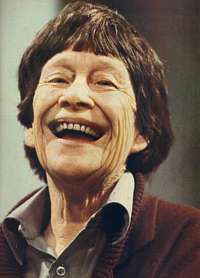Related Research Articles

Sheila Mary Florance was an Australian theatre, television and film actress. She played numerous roles in the Crawford Productions before playing Dossie Rumsay in the rural series Bellbird but became best known internationally for her performance as elderly, alcoholic convict Lizzie Birdsworth in the television series Prisoner.

Raymond Evenor Lawler is an Australian actor, dramatist, and theatre producer and director. His most notable play was his tenth, Summer of the Seventeenth Doll (1953), which had its premiere in Melbourne in 1955. The play changed the direction of Australian drama. The story of The Doll is preceded by Kid Stakes, set in 1937, when the characters of The Doll are young adults, and then Other Times, which is set in 1945 and includes most of the same characters.
Ronald Grant Taylor was an English-Australian actor best known as the abrasive General Henderson in the Gerry Anderson science fiction series UFO and for his lead role in Forty Thousand Horsemen (1940).

The Athenaeum or Melbourne Athenaeum at 188 Collins Street is an art and cultural hub in the central business district of Melbourne, Victoria, Australia. Founded in 1839, it is the city's oldest cultural institution.
The Green Room Awards are peer awards which recognise excellence in Cabaret, Dance, Theatre Companies, Independent Theatre, Musical Theatre, Contemporary and Experimental Performance and Opera in Melbourne.
The following lists events that happened during 1955 in Australia.

The Princess Theatre, originally Princess's Theatre, is a 1452-seat theatre in Melbourne, Victoria, Australia. Established in 1854 and rebuilt in 1886 to a design by noted Melbourne architect William Pitt, it is the oldest surviving entertainment site on mainland Australia. Built in an elaborate Second Empire style, it reflects the opulence of the "Marvellous Melbourne" boom period, and had a number of innovative features, including state of the art electric stage lighting and the world's first sliding ceiling, which was rolled back on warm nights to give the effect of an open-air theatre.
Ernest Henry Clark Oliphant, commonly referred to as E. H. Oliphant or Professor Oliphant, was an Australian journalist, an authority on Elizabethan literature, a popular public speaker and occasional playwright.
The Australian Elizabethan Theatre Trust is a theatre and performing arts company that was founded in September 1954, with the aim of establishing drama, opera and ballet companies nationally.

The Comedy Theatre is a 1003-seat theatre in Melbourne's East End Theatre District. It was built in 1928, and was designed in the Spanish style, with a Florentine-style exterior and wrought-iron balconies. It is located at 240 Exhibition Street, and diagonally opposite Her Majesty's Theatre.
Richard Bruce Wherrett AM was an Australian stage director, whose career spanned 40 years. He is known for being the founding director of the Sydney Theatre Company in 1979.

Australian rules football was one of two demonstration sports at the 1956 Summer Olympics held in Melbourne.
Lloyd Berrell was a New Zealand actor who played Reuben "Roo" Webber in the original Sydney production of Summer of the Seventeenth Doll. He worked extensively in Australian radio and theatre, appearing in a large portion of the films being shot locally at that time. He also starred in the original stage production of Sumner Locke Elliott's Rusty Bugles as well as numerous productions for the Mercury Theatre.
The Torrents is a 1955 Australian play by Oriel Gray, set in the late 19th century, about the arrival of a female journalist in an all-male newspaper office, and an attempt to develop irrigation-based agriculture in a former gold mining town.
Alan Burke was an Australian writer and film director and producer. His credits include the musical Lola Montez.
Lesbia Thorpe (1919–2009) was an Australian artist, possibly best known for her printmaking.
Jack Beresford Fowler, generally referred to as Beresford Fowler or J. Beresford Fowler, was an Australian actor and stage director, remembered for his little theatre productions in Melbourne.
Irene Gladys Mitchell was an Australian actor and theatre director, prominent in the little theatre movement in Melbourne.
The Tintookies is a 1956 Australian musical comedy from Peter Scriven. Produced with marionettes, it was produced by the Elizabethan Theatre Trust.
Ned Kelly is a 1942 Australian stage play by Douglas Stewart based on his radio play of the same name.
References
- ↑ "Museum gets Games "lift"". The Argus (Melbourne) . Victoria, Australia. 18 September 1956. p. 3. Retrieved 13 November 2023– via National Library of Australia.
- ↑ "The big Games chief on way". The Argus (Melbourne) . Victoria, Australia. 14 November 1956. p. 3. Retrieved 13 November 2023– via National Library of Australia.
- ↑ Olympic Arts Festival, Australian Performing Arts Collection
- ↑ "Games visitors will see... NED AT HIS". The Argus (Melbourne) . Victoria, Australia. 6 October 1956. p. 3. Retrieved 13 November 2023– via National Library of Australia.
- ↑ "FESTIVAL ART IS A WINNER". The Argus (Melbourne) . Victoria, Australia. 20 November 1956. p. 8. Retrieved 13 November 2023– via National Library of Australia.
- ↑ "GREAT MUSIC FOR THE OLYMPICS!". The Argus (Melbourne) . Victoria, Australia. 27 November 1956. p. 8. Retrieved 13 November 2023– via National Library of Australia.
- ↑ "ART". Architecture and arts. No. 43. March 1957. Retrieved 13 November 2023– via Trove.
- ↑ "Music goes to gardens". The Argus (Melbourne) . Victoria, Australia. 15 November 1956. p. 6. Retrieved 13 November 2023– via National Library of Australia.
- ↑ "What Goes On". The Argus (Melbourne) . Victoria, Australia. 19 November 1956. p. 1. Retrieved 13 November 2023– via National Library of Australia.
- ↑ "Arts Festival". The Argus (Melbourne) . Victoria, Australia. 19 November 1956. p. 8. Retrieved 13 November 2023– via National Library of Australia.
- ↑ "Woman's Page 2". The Argus (Melbourne) . Victoria, Australia. 2 November 1956. p. 15. Retrieved 13 November 2023– via National Library of Australia.
- ↑ "... AND AT THE THEATRE A too-wordy play". The Argus (Melbourne) . Victoria, Australia. 26 November 1956. p. 8. Retrieved 13 November 2023– via National Library of Australia.